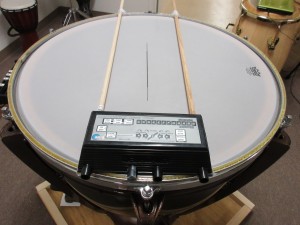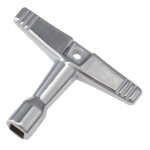I got to experience a RESOTUNE II this last week, hands on tuned a couple kits. What I believe is not immediately understood about the RESOTUNE is that its a computerized tone generator, its actually much more than that, but if you can imagine a device that generates tones and reads the feedback it gets when these tones are applied to a drum, a drum with heads of course (as that's how you play your acoustic drums), you might more easily understand how this devise does what it does. Its not you the tuner tapping the head generating the tones, its the units microprocessor executing perfection each and every time, so the results are of a level of consistency not humanly obtainable with just a drum key and your ears.
"RESOTUNE literally measures the clear quality of the entire system working together as it does when played, so ignores or factors in, sundry mechanical errors."
Is what John says and that 'is' what RESOTUNE does, it analyzes the drum as complete drum, and it does so with tones it generates and analyzes the info in a microprocessor. The results are displayed by LED's and the whole effect and end sonic result is quite amazing I must say.
Do I need a devise to tune my drums? No, I can tune drums really well actually, but what I realized after using RESOTUNE is that it accomplishes exactly what Im trying to do in a short amount of time. What RESOTUNE also made me realize is, I could spend 8 hrs, 8 days, or even 8 weeks tuning a drum kit and I would't be able to tune as accurately as RESOTUNE, the human ear is just too subjective and influenced by too many outside variables all the time (your perception of sound/accuracy of tones can change if you drink a glass of water). So yeah, I'll never be a good as RESOTUNE at tuning drums, again, it does what Im trying to do and it can do it a lot quicker.
The above didn't really come as a surprise, I assumed I'd hear something I haven't heard out of a drum kit before, the purest note form and cleanest fundamental I've ever heard. Could I have gotten this with just my ears and a drum key? Gotten close, but not nailed it like RESOTUNE. The difference between close and nailing it? Let's just say the sound is noticeable, noticeably better, as in you've never heard it 'this good' before.
Let's get back to "...so ignores, or factors in, sundry mechanical errors." which is a big part of the beauty of RESOTUNE IMO. It doesn't care what heads you have on, what combination of heads, if there's nylon washers, a few different tension rods, it sonically analyzes the drum 'as it is' and provides you with a solution to 'clear' the lug notes. You do this by turning a drum key and RESOTUNE guides you both sonically (you can hear the target note audibly when its achieved), and with LED confirmation like a guitar tuner display.
The whole RESOTUNE tuning process is actually pretty easy once you understand what's going on, the most time consuming part of the process is repositioning the unit over each lug to tune them to 'clear', but the more you do this the easier it becomes. I found myself going around twice which is totally understandable. Those 'sundry mechanical errors' that exist in every drum are computed and recomputed by RESOTUNE with each turn of the drum key, and you reach a state of lug-clear with the unit accurately confirming the results, something ones ears simply can't do to the same degree. Those 'results' are in the realm of- "Holy crap this drum sounds in tune like I've never heard before!" and "Im excited to play now!" along with "That wasn't hard, it was fun." Do it once an you're addicted, addicted because the resulting sound is so good.
$175 for a drum tuning devise? There's simply nothing out there that can get your drums this in-tune, the scope of which you can't comprehend until you actually hear the results, or so it was with me and I've been doing this since the 60's.
Do you need your drums in tune to notes? Your drums are tuned to notes, the fact of the matter is they're not tuned to notes as accurately as RESOTUNE can help you get them. Its like once you take a shower, you want to be clean. You control your drum sound destiny with RESOTUNE, no more walks in the dark when tuning, its like night and day, you can see where you're going, and you can now get there quick. After my experience with it, I can't imagine not having a RESOTUNE, it allows you to produce that sound you've always wanted to hear.
Recognizing a cleared drum, or pitches, or whatever, is something one learns. If one can learn to play beats, or fills, or any other part of playing, one can learn to tune. Any other answer is an excuse. It's a cop-out.
I could see myself saying that... almost anyway. You 'can' learn and I did, but I can attest I'll never be a able to zero it in like RESOTUNE, its just not humanly possible to be that accurate, and if you did ever become 'lucky' on one head of one drum, you'll never be able to do it as fast as you can with the help of RESOTUNE. The results speak for themselves, until you hear those results you simply can't comprehend a drum (kit- yes even the BD) this 'in tune' is my conclusion.
I agree there needs to be better, more detailed vids on the RESOTUNE and its how too's. The fact we have John Roberts the inventor posting on this thread is fantastic! The RESOTUNE for all intensive purposes in the drumming community is simply genius. Im a convert.




